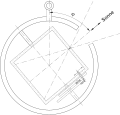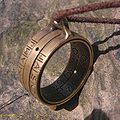Eye sundial
The eye sundial is a variant of the sundial with a nodus . Instead of the small ball (or the tip of a rod), which is often used, a perforated screen (an eye ) acts . Instead of a punctiform shadow, the cover casts a spot of light as a pointer onto the dial of the sundial.
The most famous eye sundial is the eye sundial by Philipp Matthäus Hahn , a Swabian pastor, designer and inventor. Philipp Matthäus Hahn built this sundial around 1767 in order to add it to his mechanical clocks for checking and readjusting.
"Monumental" sundials were set up between the 16th and 18th centuries as noon in some major churches in Italy ( called Meridiana ) and France ( Méridienne ): The eye is a round hole in the south wall of these churches. A sunspot falls on the noon line on the floor in the relatively dark church at noon. They show the moment of noon and the height of the midday sun, which changes over the year. These clocks are considered scientific instruments that the Catholic Church began to use at that time. '
Noon is also available in the size of a normal sundial. It is advantageous to use a round hole as a node because the resulting light spot is sharper than a corresponding shadow point. Since reading is only done at noon, there is no disadvantage that you would have to turn the pinhole diaphragm towards the sun during the day (always towards it), which is not necessary with a shadow-casting sphere.
In the broadest sense, a midday cannon (also known as a meridian cannon ) can also be counted among the ear sundials. This gimmick of clock technology was very popular from the second half of the 18th century to the beginning of the 19th century. The eye is the opening of a miniature cannon barrel into which a magnifying glass is inserted. The cannon was oriented in such a way that when the sun was at its highest point (at noon) the rays of the sun, bundled in the magnifying glass, ignited a powder charge and fired the cannon.
The farmer's rings are known from earlier modern times , simple portable all-day sundials with a light spot cast on the inner surface of the ring.
- Examples of eye sundials
Hahn's eye sundial (schematic)
Mèridienne ( St-Sulpice de Paris )
Midday meal for midday ( Aix-en-Provence , Place Richelme)
Midday cannon ( Residenzschloss Ludwigsburg )
Individual evidence
- ↑ Weblink fokus.de/wissen "Ray of Knowledge"
- ^ Ernst von Bassermann-Jordan, Hans von Bertele: Uhren. Klinkhardt & Biermann, Braunschweig 1969.
- ↑ The midday cannon should not be confused with cannons that are fired at noon to indicate the time, e.g. B. the Noon Gun in Cape Town.
- ^ Ernst von Bassermann-Jordan, Hans von Bertele: Uhren. Klinkhardt & Biermann, Braunschweig 1969, p. 112.
- ↑ Fritz von Osterhausen: Callweys lexicon. Callwey, Munich 1999, ISBN 3-7667-1353-1 , p. 211 (with illustration).
- ↑ Reinhard Meis: Die Alte Uhr, vol. 1. Klinkhardt & Biermann, Braunschweig 1978, ISBN 3-7814-0116-2 , p. 56 (with illustration).
- ↑ Jürgen Abeler: The Wuppertal clock museum. Walter de Gruyter, Berlin 1971, p. 42 (with illustration).





